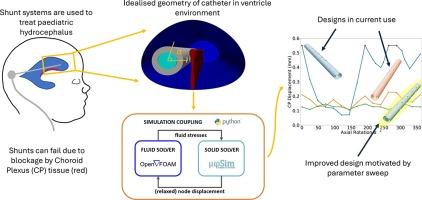简化模型辅助分流系统流固交互设计框架
IF 2.3
4区 医学
Q3 ENGINEERING, BIOMEDICAL
引用次数: 0
摘要
传统上,临床设备是通过漫长而昂贵的实验室实验和临床试验来设计、测试和改进的。最近,计算方法允许快速测试,加速设计过程,并使更完整的设计空间搜索成为可能。虽然计算模型不能完全捕捉生物系统的复杂性,但它们为关键的潜在机制提供了有价值的见解,例如流固相互作用(FSIs)的影响。在本文中,我们提出了一个模块化,分区,计算FSI管道,其中二维降阶模型指导感兴趣的问题的三维设计。该框架适用于脑积水分流闭塞的问题。脑积水是一种以脑脊液(CSF)过多为特征的医学病症,通常通过插入分流系统进行治疗。该系统包括一个心室导管组件——一个位于大脑侧脑室的空心管,其入口孔位于靠近封闭尖端的管壁上。尽管最近导管材料有所改进,但这种治疗仍然有很高的失败率,最常见的原因是脉络膜丛(ChP)组织阻塞导管。我们使用一个理想化的FSI模型来比较现有的导管设计,通过考虑脑积水情况下脑室环境中脑脊液流下ChP的变形。据我们所知,这是第一个直接结合ChP变形来区分导管设计的计算框架。更快的2D模型用于导管设计领域的综合参数扫描,并激发新的设计,然后在全3D领域进行测试时确认是一种改进。这种方法证明了使用降阶方法来指导更复杂问题的设计的成功。本文章由计算机程序翻译,如有差异,请以英文原文为准。

Reduced model aided fluid-structure interaction design framework for shunt systems
Traditionally, clinical devices are designed, tested and improved through lengthy and expensive laboratory experiments and clinical trials [1]. More recently, computational methods have allowed for rapid testing, speeding up the design process and enabling far more complete searches of design space. While computational models cannot fully capture the complexities of biological systems, they provide valuable insights into crucial underlying mechanisms, such as the effects of fluid-structure interactions (FSIs). In this paper we present a modular, partitioned, computational FSI pipeline whereby 2D reduced order models guide the 3D design of the problem of interest. This framework is applied to the problem of hydrocephalus shunt occlusion. Hydrocephalus is a medical condition characterised by an excess of cerebrospinal fluid (CSF) in the brain, and is commonly treated with the insertion of a shunt system. This system includes a ventricular catheter component – a hollow tube with inlet holes arranged in the tube wall close to the closed tip – which is positioned in the lateral ventricles of the brain. Despite recent improvements in the catheter material, this treatment still has high failure rates, most often due to the blockage of the catheter by the Choroid Plexus (ChP) tissue. We use an idealised FSI model to compare existing catheter designs by considering the deformation of the ChP under CSF flow in the ventricle environment in an hydrocephalus scenario. To the best of our knowledge, this is the first computational framework to directly incorporate the deformation of the ChP to discriminate between catheter designs. The faster 2D model is used in a comprehensive parameter sweep of the catheter design domain, and motivates a new design, then confirmed to be an improvement when tested in the full 3D domain. This approach demonstrates the success of using reduced order methods to guide the design of a more complex problem.
求助全文
通过发布文献求助,成功后即可免费获取论文全文。
去求助
来源期刊

Medical Engineering & Physics
工程技术-工程:生物医学
CiteScore
4.30
自引率
4.50%
发文量
172
审稿时长
3.0 months
期刊介绍:
Medical Engineering & Physics provides a forum for the publication of the latest developments in biomedical engineering, and reflects the essential multidisciplinary nature of the subject. The journal publishes in-depth critical reviews, scientific papers and technical notes. Our focus encompasses the application of the basic principles of physics and engineering to the development of medical devices and technology, with the ultimate aim of producing improvements in the quality of health care.Topics covered include biomechanics, biomaterials, mechanobiology, rehabilitation engineering, biomedical signal processing and medical device development. Medical Engineering & Physics aims to keep both engineers and clinicians abreast of the latest applications of technology to health care.
 求助内容:
求助内容: 应助结果提醒方式:
应助结果提醒方式:


